There are always a few surprise packages outside the top three teams in the Portuguese top-flight division, four if you include SC Braga.
Last season, these were both Paços de Ferreira and Santa Clara who managed to finish fifth and sixth respectively, earning the final two European spots.
The addition of the UEFA Europa Conference League has allowed Primeira Liga to have six European qualification spots up for grabs across the ECL, the Europa League, and of course, the Champions League.
One of the beneficiaries of the increase in continental football is Portugal’s historical minnows Estoril Praia. The club, with a stadium capacity of just 8,000, last reached any European competition back in 2013 when they were coached by the current Fulham and former Everton boss Marco Silva.
Now, Bruno Pinheiro hopes to take the Canarinhos back to the promised land. Right now, Estoril are sitting fourth in the table, having lost just one match in the opening eleven fixtures, which was against the champions Sporting Clube de Portugal.
Estoril won Liga Pro last season and have put themselves forward as early top six contenders, playing some of the most tactically interesting football in the league.
This article will be a tactical analysis of Estoril in the form of a team scout report. It will be an analysis of the tactics deployed by Pinheiro using the personnel available to him.
Formation choice and starting lineup
Pinheiro has stuck with his principles and philosophy this season despite the promotion from the second-tier to the top division in Portugal. The 45-year-old has deployed a 4-3-3 as Estoril’s main choice of system so far in the current campaign.
The 4-3-3 is merely a base formation for the side to structure themselves around, particularly in the defensive phases. As we will observe later in this article, Estoril also tends to switch to a back five depending on the game phase, while their shape differs in possession too.
The 4-3-3/4-1-4-1/4-5-1 has essentially been their substructure, and the conventional formation has been used in 74 percent of the Portuguese outfit’s matches so far this season.
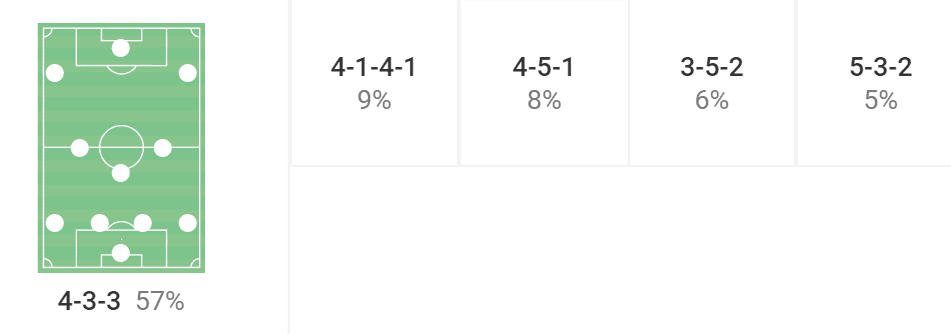
Pinheiro prefers this shape because it suits the players at his disposal which is the most important factor the coach must consider when selecting their system. For instance, if a team has just one centre-forward, why would the coach select a two-striker formation?
The manager has been quite consistent with his team selections so far this season and opts to choose players that allow his philosophy to take shape on the pitch. Here is Estoril’s most used starting lineup so far in the 2021/22 campaign:
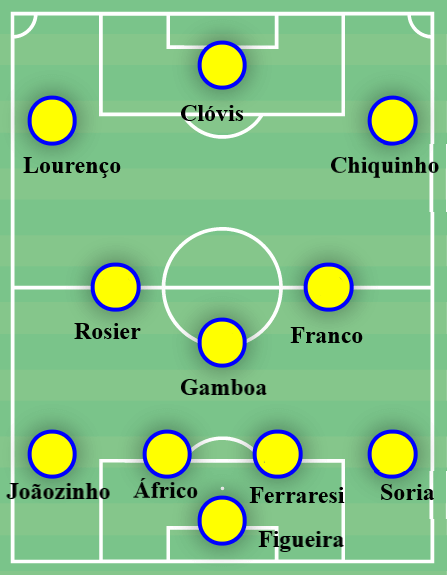
These seem to be the players that Pinheiro trusts the most to carry out his tactical instructions on the pitch, but each player has a different profile which allows the team to be rather multi-dimensional, particularly in possession of the ball.
Daniel Figueira is an excellent choice in goal as the 23-year-old is efficient with the ball at his feet. Estoril like to mix it up when playing out from the back, which will be analysed in further detail. The young Portuguese keeper is solid at playing long and short and so gives his side this dimension.
The back four generally consists of club captain Joaozinho, Lucas Africo, Nahuel Ferraresi, and Carles Soria. The two fullbacks are good going forward, especially Soria who gets more license from the manager while the central defenders complement each other well.
Ferraresi is really comfortable in possession and is a right-footed centre-back with Africo being left-footed. The highly-rated Venezuelan international Ferraresi, on loan from Manchester City, is certainly the better of the two but Africo is an extremely reliable player out of possession too.
The midfield is the most interesting aspect of Estoril’s team, especially Joao Gamboa. As we will discuss later in this tactical analysis piece, the 25-year-old plays in the lone pivot role but is far from a typical deep-lying playmaker.
Gamboa is tasked with essentially being an auxiliary central defender for the most part due to his defensive capabilities. Pinheiro’s 4-3-3 is the perfect system for Gamboa to play to his strengths in this regard as he is not the greatest passer of the ball.
In more advanced roles are Loreintz Rosier and Andre Franco. The former is more of a defensive player and so is used in quite a restricted role in possession while the latter likes to play high in the halfspace. This creates the perfect ‘6’, ‘8’, and ‘10’ midfield for Estoril.
Finally, the forward line is one department that Pinheiro chops and changes depending on the opposition. However, Bruno Lourenço and Chiquinho have been Pinheiro’s two main options this season.
The pair can play as inside forwards but also ‘touchline-huggers’ keeping the width, flanking Andre Clovis. Clovis is not an out-and-out striker and has struggled for goals this season but offers height up top, runs in behind, and hold-up play – all important attributes to the manager’s tactical system.
Progressing the ball from deeper areas
It is extremely important to highlight the capabilities of each player within a structure when analysing how a manager sets his side up from a tactical perspective.
This is because tactics are a way to get the best out of players and to give them the greatest possible framework to play well and succeed. Tactics are deployed to enhance a player’s ability, not hinder it.
Now that the player profiling of Estoril’s players have been detailed, let’s take a look at their tactical setup in possession. As already stated, the Canarinhos do play out from the back, as with any modern side, but can switch it up by going long when necessary.
Nonetheless, when in the build-up phase, the centre-backs split wide to the edge of the box, allowing the goalkeeper to essentially become a third central defender.
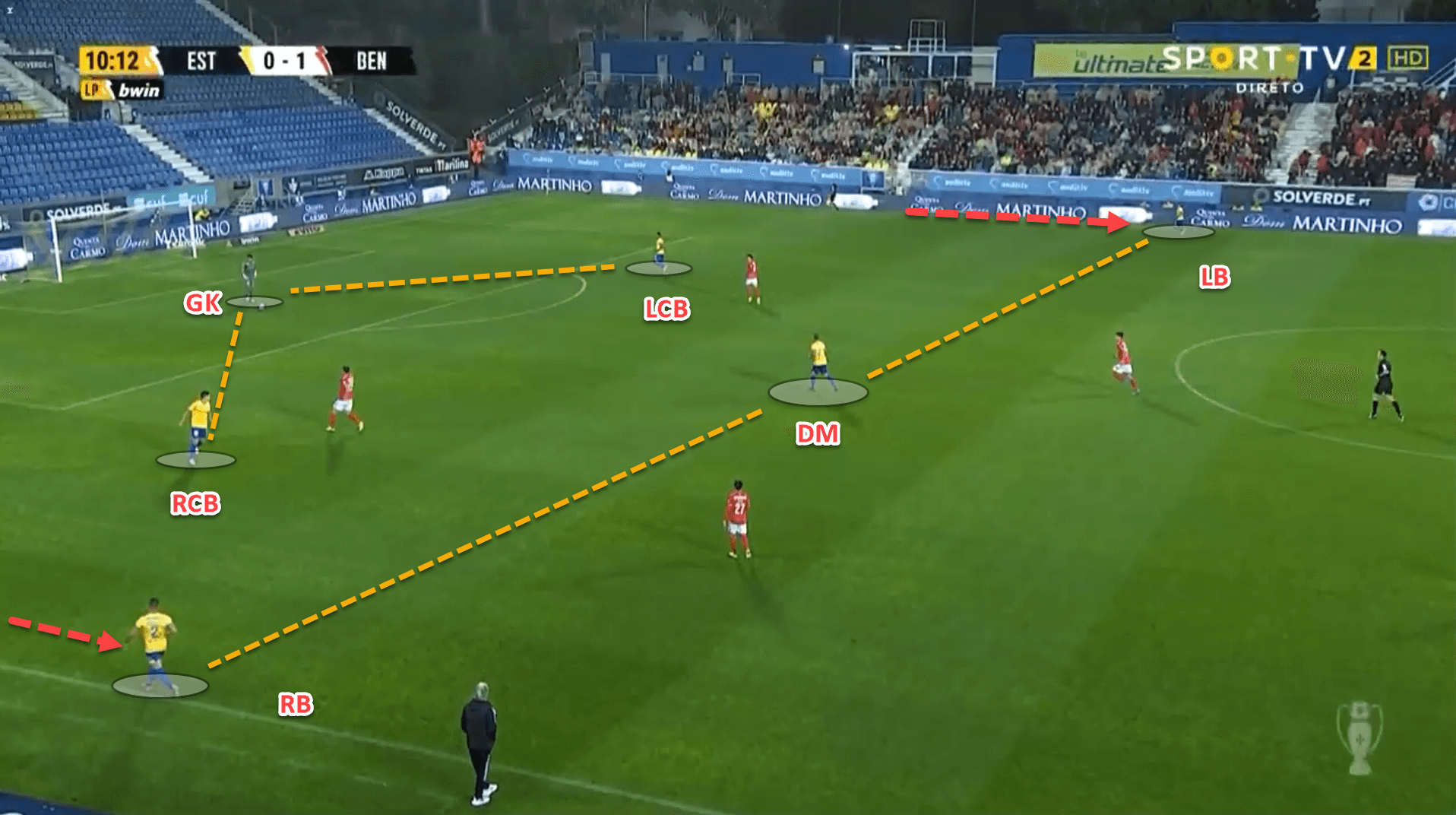
The fullbacks position themselves high in the phase as the goalkeeper and two central defenders already have numerical superiority against the opposition’s backline, as can be seen in the above image.
Meanwhile, the defensive midfielder occupies space behind the opponent’s first line of pressure. It cannot be seen due to the limitations of the skewed camera footage, but the wingers stay high and wide, too, while the advanced midfielders stay between the lines in staggered positions. This way, Estoril can create plenty of width as well as depth which makes ball progression easier.
Gamboa is not as comfortable with the ball at his feet as one might expect from a player being utilised as a number ‘6’ which means that progressing the ball from the central areas is difficult.
However, to combat this, Estoril look to break from the first third of the field into the middle third through the wide areas and combination play between the wingers, fullbacks, and midfielders.
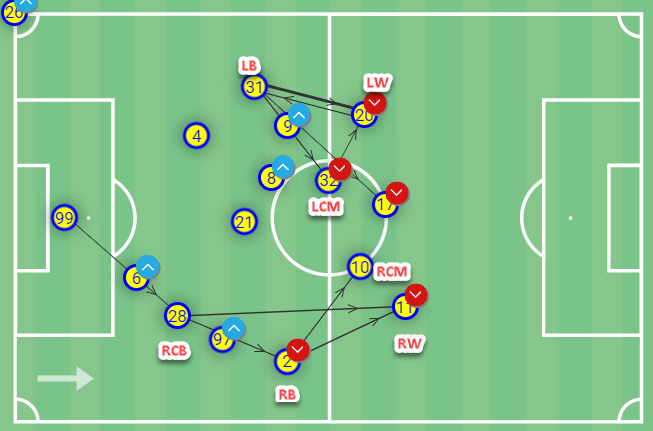
This graphic has plotted the average positions of Estoril’s players from one of the team’s most recent league matches. It also highlights the most used forward passing patterns by Pinheiro’s side.
It is clear from watching Estoril in this phase that the manager wants his side to play down the flanks and create deep, wide overloads in the wide areas to ensure that the possession is as clean as possible with progress generally being initiated by the fullbacks.
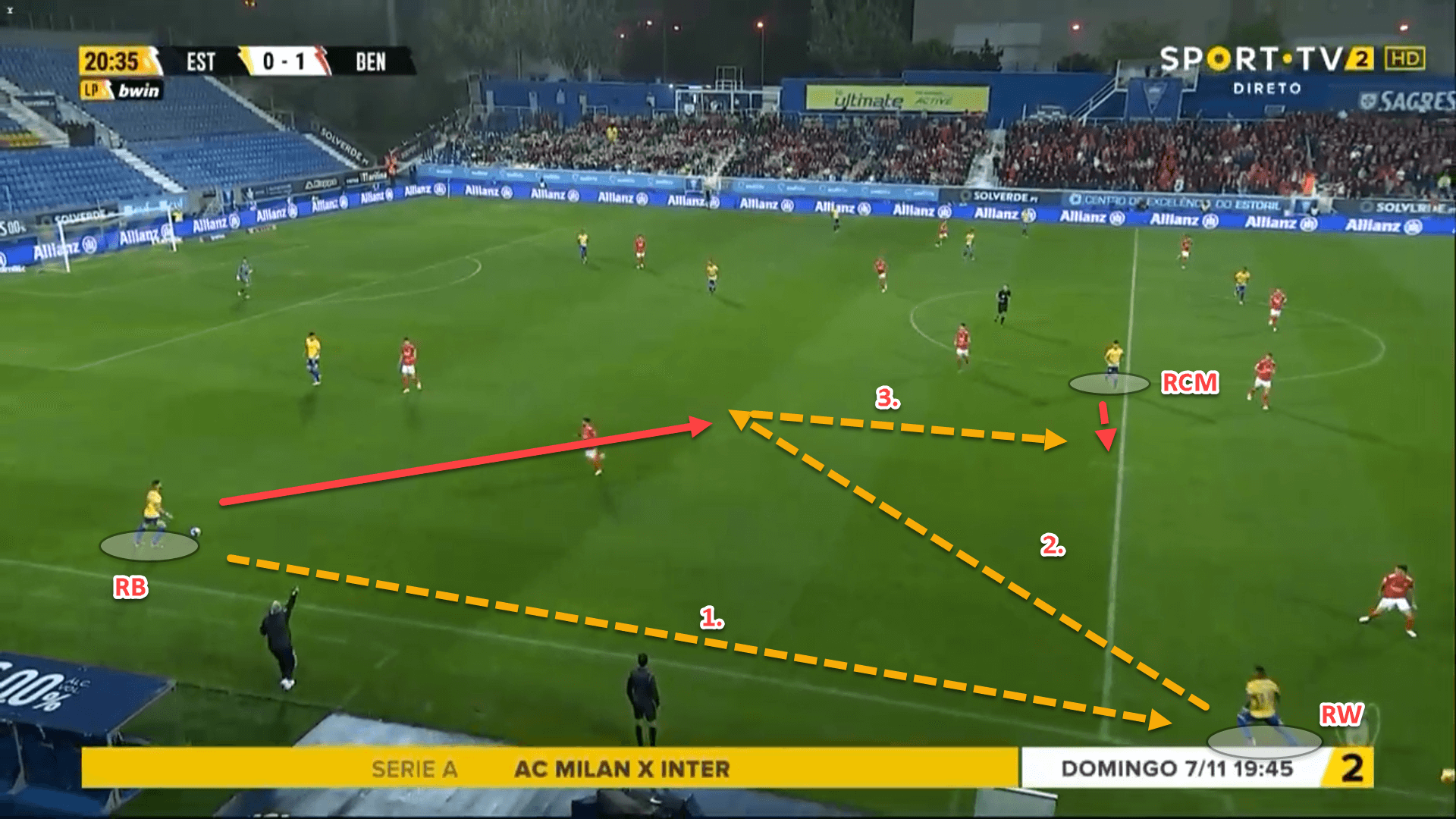
Here, progression is initiated from the fullback, who plays the ball down the line, to the ball-near winger. A quick one-two finds the right-back once again, who plays it into the nearest advanced midfielder, who moves into space to receive. This is an example of how Estoril can progress the ball from the first phase to the second phase cleanly. When in full flow, the Portuguese minnows are rather efficient.
However, clean progression is not always possible. Sometimes, the players will need more solutions to bypass the opposition’s press. When situations like this arise, Estoril go long down the line. Again, this is generally instigated by the fullbacks who look to find the runs of either the winger or ball-near central midfielder in behind.
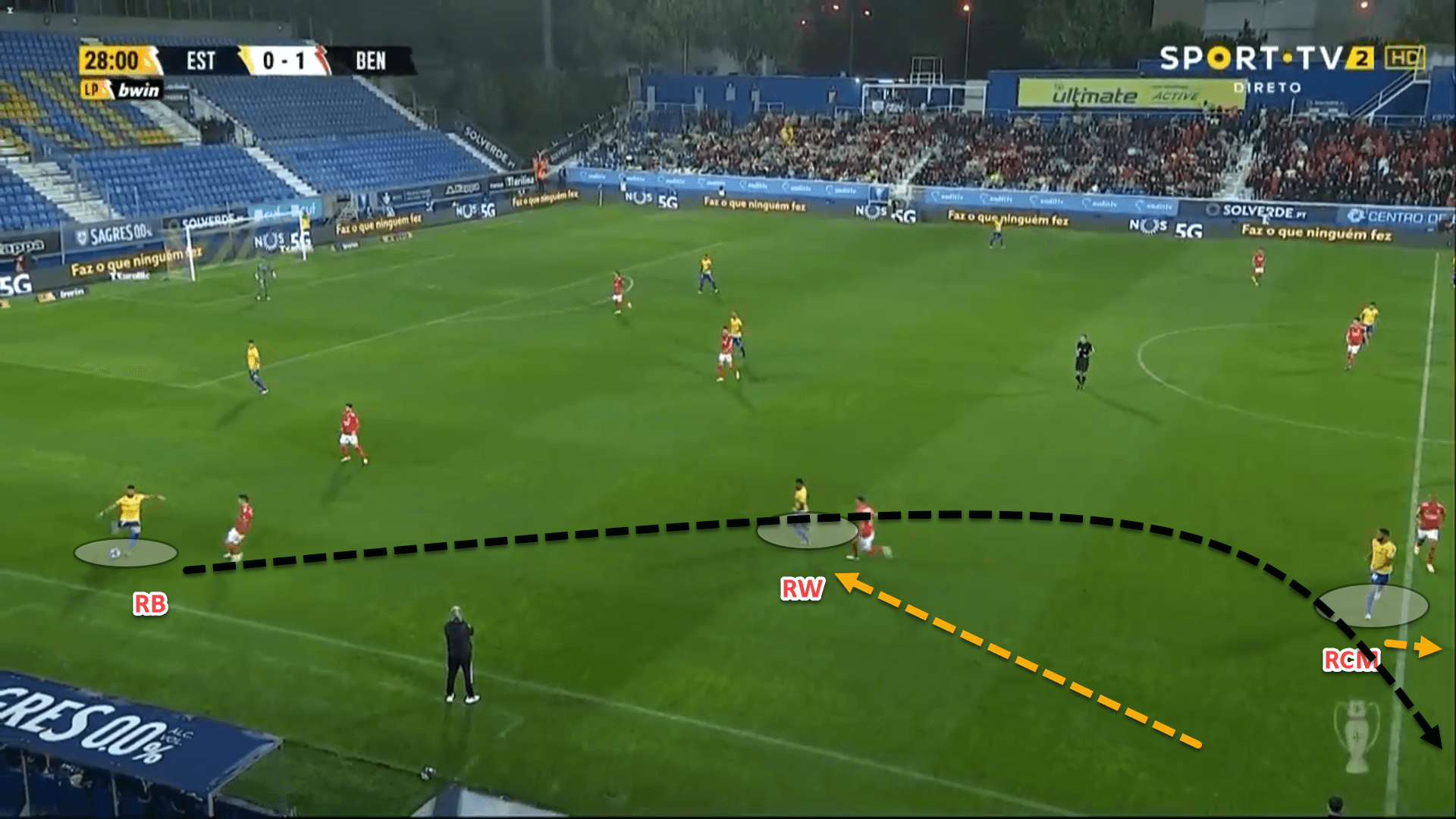
In this instance, the ball-near winger has dropped short to receive but the passing lane has been closed off by the Benfica player who is pressing the ball-carrier. In doing so, his marker has followed, and space opens up for the central midfielder to exploit with an attacking run, which the player in possession spots.
Pinheiro understands that he does not have world-class talent on his hands. Players cannot always circulate possession and try to break through the opposition’s high press with short passes. It can be just as productive to play over the press.
Estoril are currently averaging 52.6 progressive passes per 90 in Primeira Liga as well as 36.23 long passes with an accuracy of 57.3 percent on the latter which is one of the highest in Portugal’s top-flight division.
Chance creation
Estoril’s main source of chance creation is through the wings. Again, the Canarinhos are not overly strong at playing through the central areas, mainly because of Gamboa’s lack of ability to break the lines. So Pinheiro instructs his side to try and break down the opponent’s deep defensive block out wide.
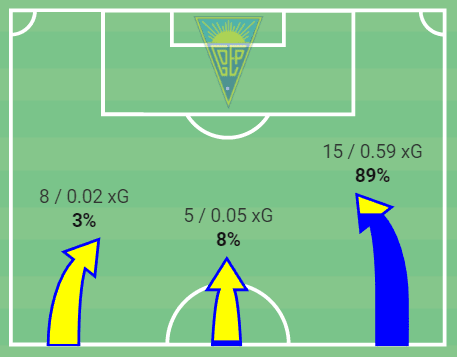
This data visualisation is from Estoril’s recent league fixture against Gil Vicente, which subsequently finished 2-2 at the Estadio António Coimbra da Mota. Out of Estoril’s 28 positional attacks, 23 came from the flanks, with just six coming from through the central corridors.
The right flank is the most used area for Pinheiro’s side as Chiquinho and Soria link up extremely well together. Again, this is a situation where the manager’s tactics must suit the strengths of the players, which they certainly do.
When Estoril have the ball in the middle third of the pitch against their opponent’s mid-block and are looking to break the defensive structure down to get into crossing positions out wide, the team does so in two ways.
Firstly, through combination play with the winger and fullback. This is rather simple but can be very effective when pulled off correctly.
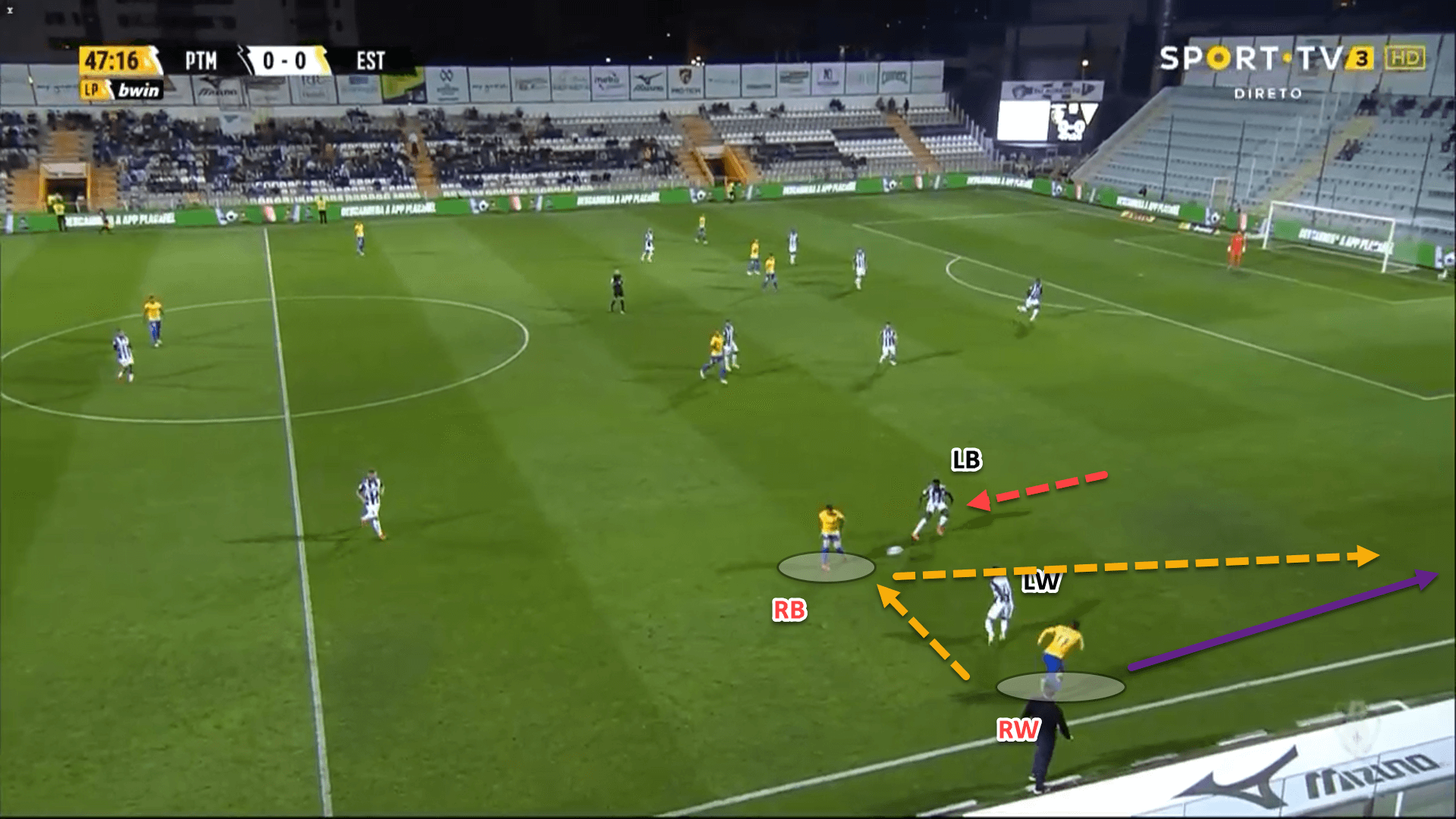
Simple combination play between the fullback and winger can allow Estoril to get into good crossing situations in the final third.
In the previous image, the opponent’s left-back has committed himself to engage with his opposite number. The Estoril winger plays a quick one-two with the fullback and is now in behind. Ultimately, Portimonense recover to deny the cross, but it’s still an example where Estoril could have had the ball in a dangerous area in the final third through such simple play.
Having combination play between just the fullback and winger also ensures that Estoril do not become unbalanced anywhere else on the field as other players do not need to come across to create an overload.
This brings us to the second way that Estoril look to break down an opponent’s defensive low block and get into optimal crossing positions which is through a principle called ‘overloading to isolate’.
This is essentially when one team creates an overload out on one flank, pulls the opposition’s defensive block across to try and defend against it, before quickly switching it to the weak side to get a wide player in a 1v1 or 2v1 situation.
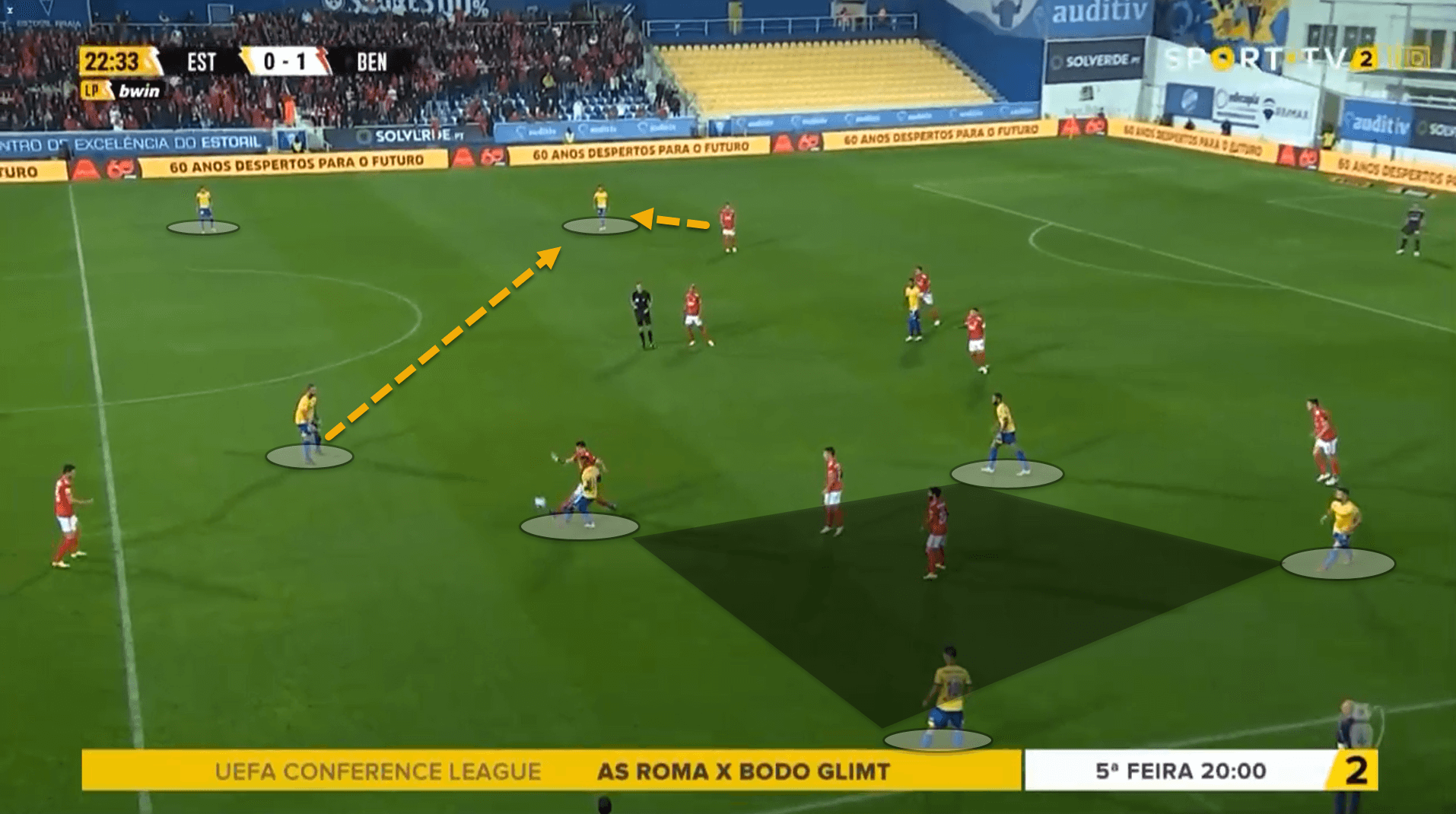
Here, Estoril have created a wide overload on the right flank. By doing so, Benfica’s 5-3-2 deep defensive block has shifted across to defend against it which has made them weaker on the opposite side of the pitch.
A quick switch of the play to the fullback or winger will put the Canarinhos in an optimal position to create a 2v1 or 1v1 situation against Benfica’s wingback before getting into a good area to cross the ball depending on how quickly the ball can be switched.
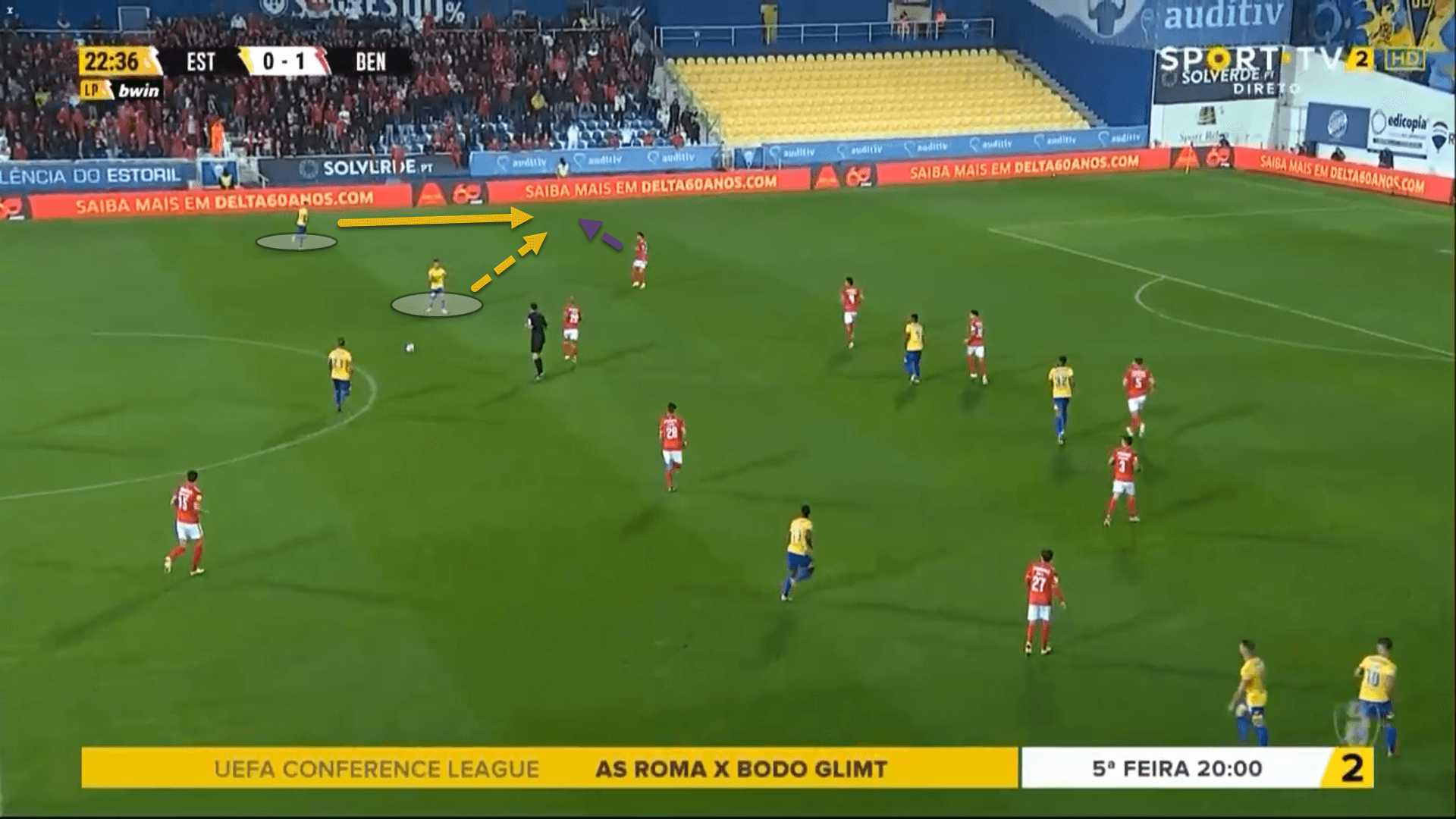
Estoril do not have a preferred crossing position. Pinheiro allows his side to mix up their crossing ranges in order to make their attacks less predictable.
Here is a data viz that plots each of Estoril’s 22 crosses from a recent game against Gil Vicente. The fullbacks (number 31 and 2) put more crosses into the area than anyone, but these tend to come from deeper positions whereas the wingers (11 and 7) cross in more advanced positions, closer to the by-line.
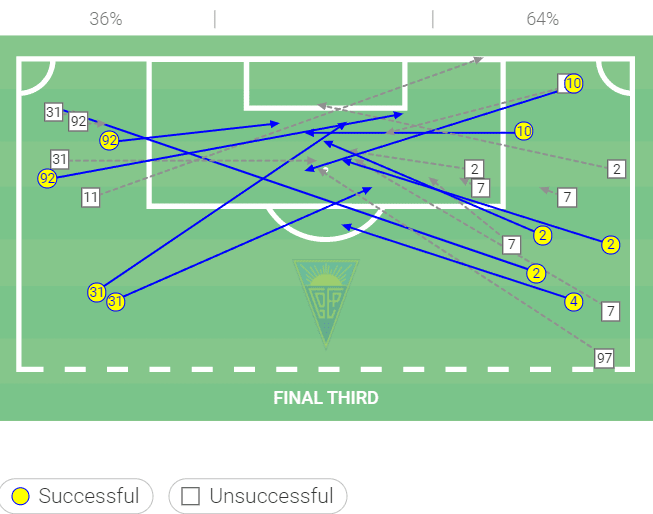
Estoril are quite reliable at crossing and can be efficient with an accuracy of 35.2 percent so far this season meaning one in three crosses are successful for them. They are the sixth-highest crossers in Primeira Liga, averaging 19 crosses per 90.
However, the issue with relying on crossing for Estoril is that this form of chance creation has a notoriously low conversion rate.
Estoril have scored 16 goals in the league this season but have been massively overperforming their xG which stands at 11.88. Estoril have been clinical, which is always a great sign, but if the goals dry up, the team are not creating enough high-quality chances to tie them over.
Conservative high block
Quite often, when discussing which teams are interesting from a tactical viewpoint, there is generally an emphasis on how the side plays in possession. We have discussed Estoril’s tactics on the ball, but Bruno Pinheiro’s style of play is just as intriguing out of possession which is mainly because of Gamboa’s role.
In typical Portuguese fashion, Estoril can be rather pragmatic in the defensive phases and Pinheiro does not want his team to overly commit bodies forward in the press. The team tend not to engage in their high press until the opposition have played the ball out of the first third of the pitch.
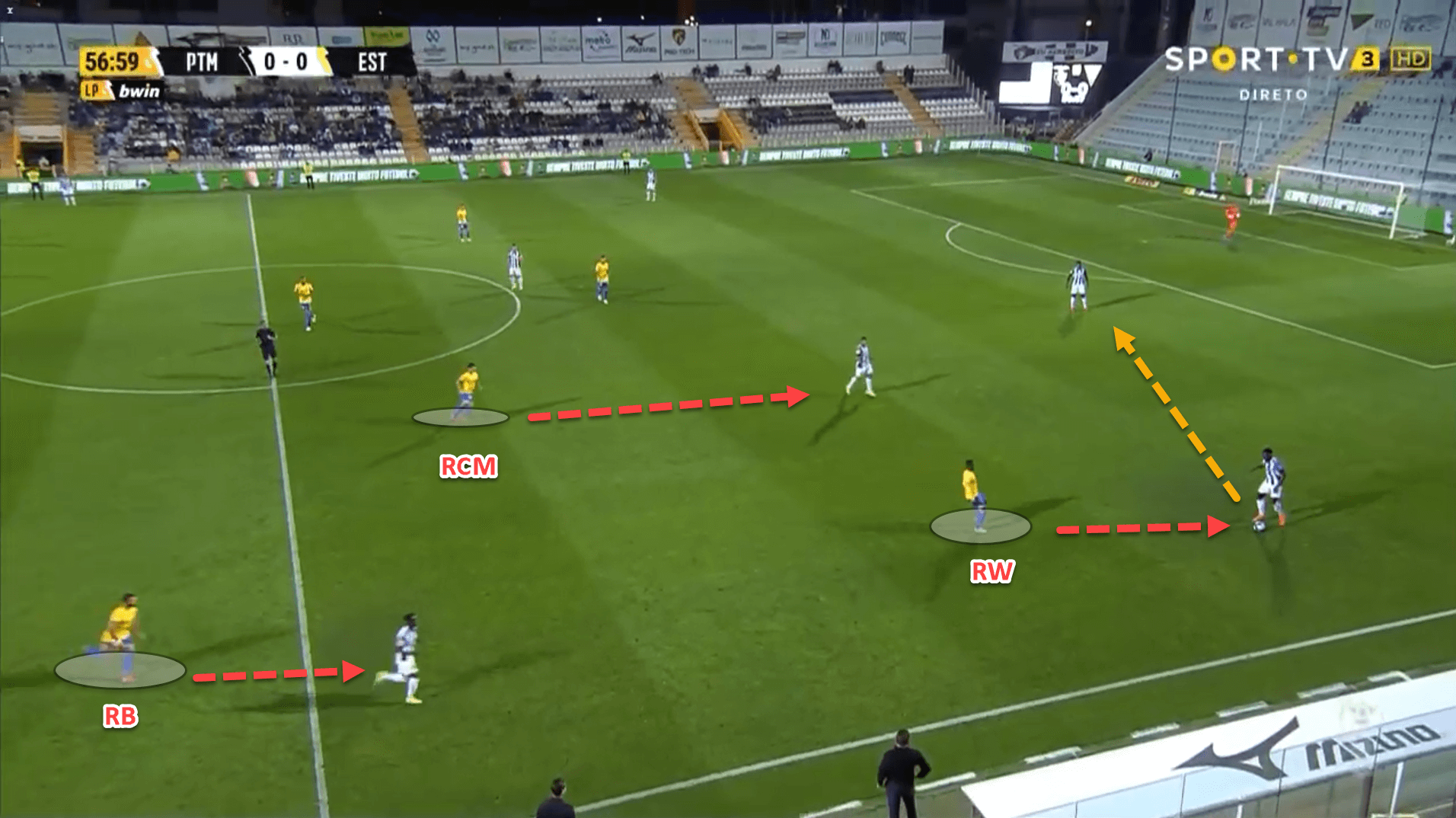
Estoril press in a man-oriented fashion, forcing the opposition to play into the wide areas before covering all the nearest options. This, in turn, forces the ball-carrier backwards or to play a long pass down the line, which can be seen in the previous image.
The team have a Passes allowed Per Defensive Action this season of 10.49 which is one of the highest in the division. The higher the PPDA, the less a team presses as they allow more passes from the opponent, although Estoril’s is still not high enough to claim that they do not press.
In this high-block phase, the intent from Estoril is never really to turn over possession, but instead to contain the team in possession, which allows Estoril to control what areas in the pitch the attacking side have to play in.
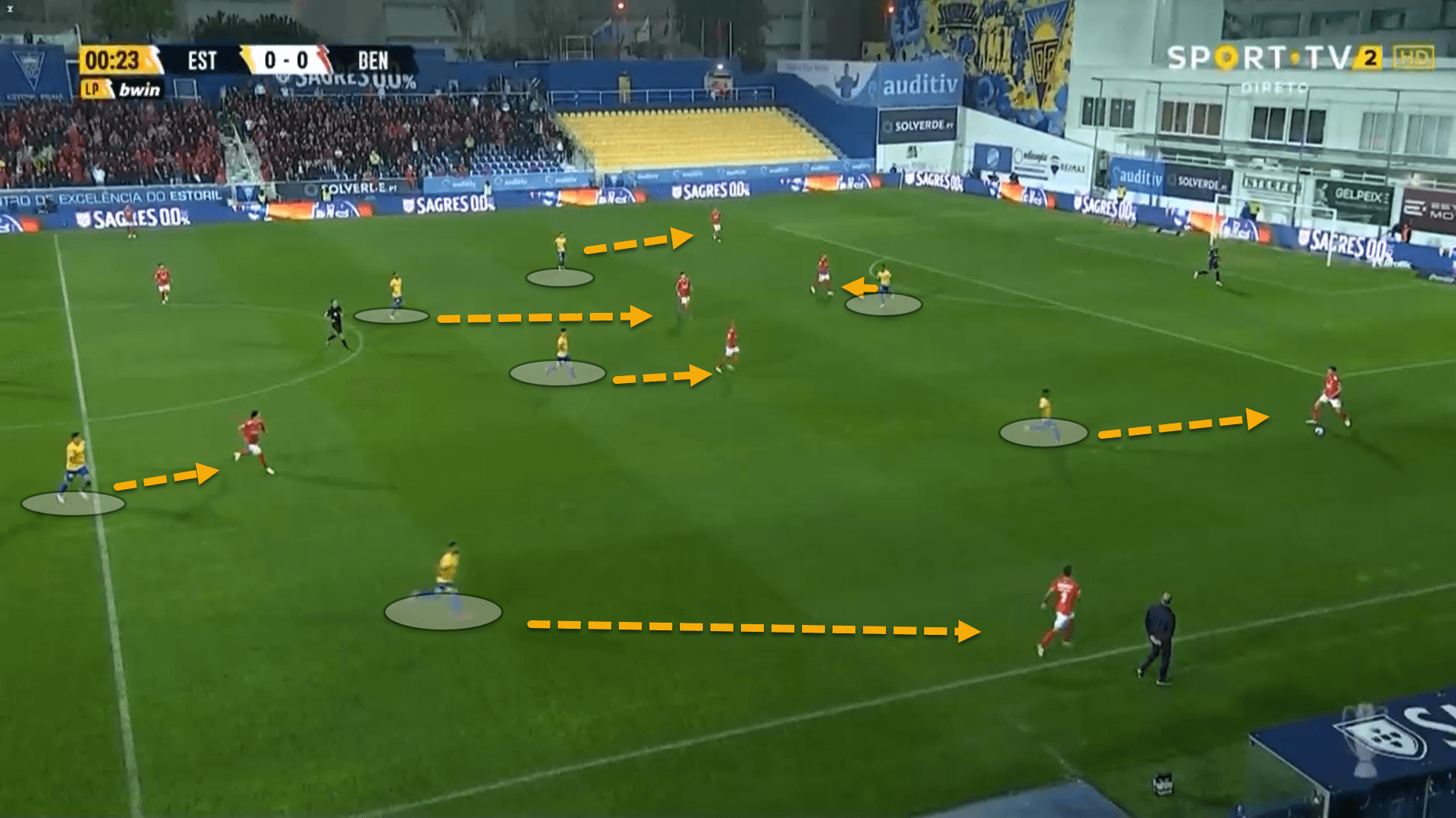
The man-to-man system can be seen here once again. The main principle of a man-oriented system is that the defending players must mark the nearest free passing option as quickly as possible to cut off the pass.
Nonetheless, this needs to be done co-harmoniously and as quickly as possible or else it will be too easy to bypass. Estoril are very good in this phase and the attacking sides tend to struggle to play through.
Mid-to-low block
This press is normally executed in a 4-3-3, the team’s base formation. When the press is broken, Estoril drop off into a compact 5-4-1 mid-block with the wingers dropping back. Gamboa, the defensive midfielder, moves in as a third centre-back to complete the shape.
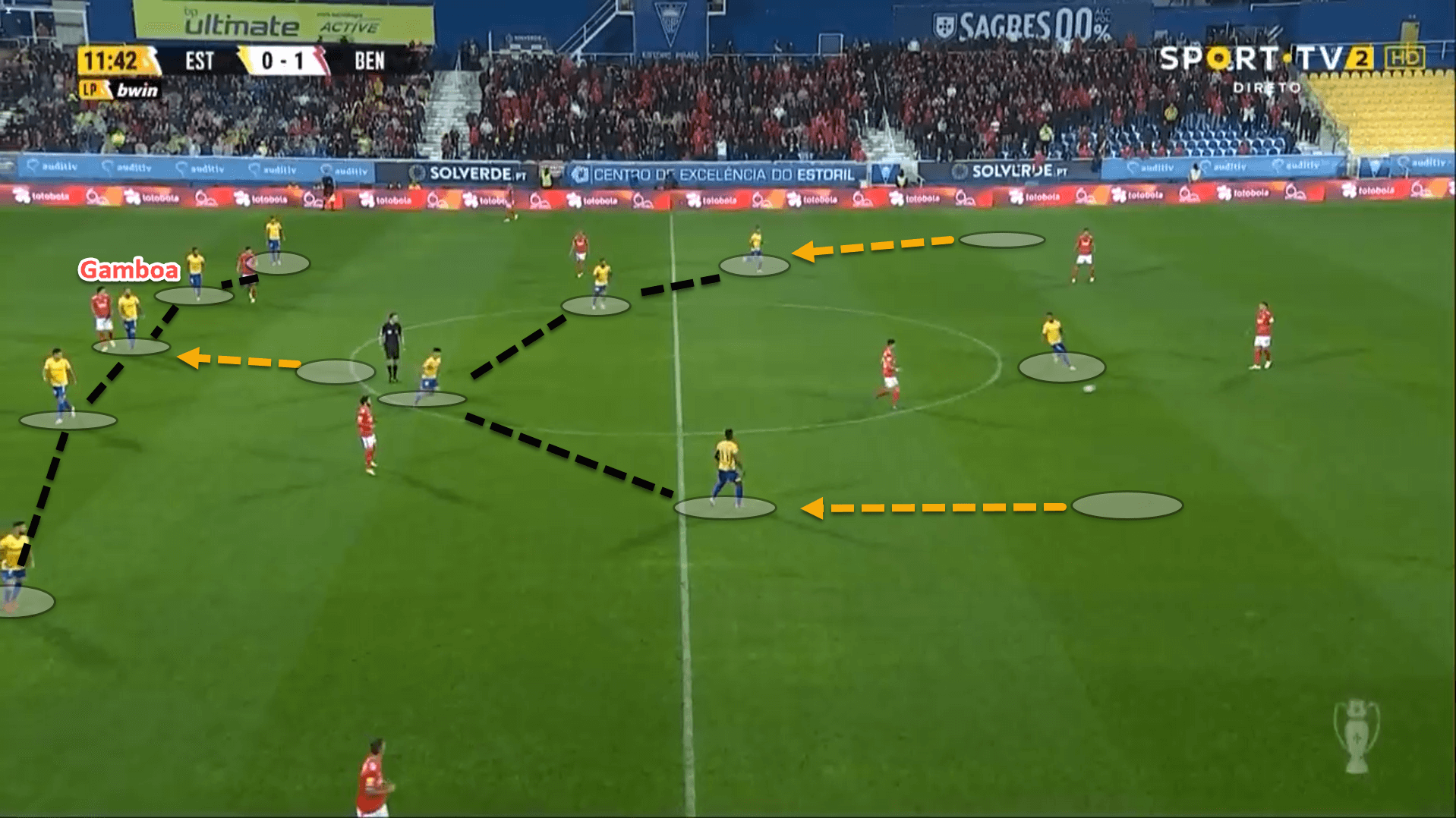
The switch to the back five allows Estoril to have far more security when defending the space between their midfield and backline.
The logic behind this is that, because there are three central defenders instead of just two, the centre-backs can be aggressive between the lines and mark attacking players tightly.
It also allows the central midfielders to double-up on players at times with the nearest centre-back, creating a defensive numerical superiority against attacking players between the lines.
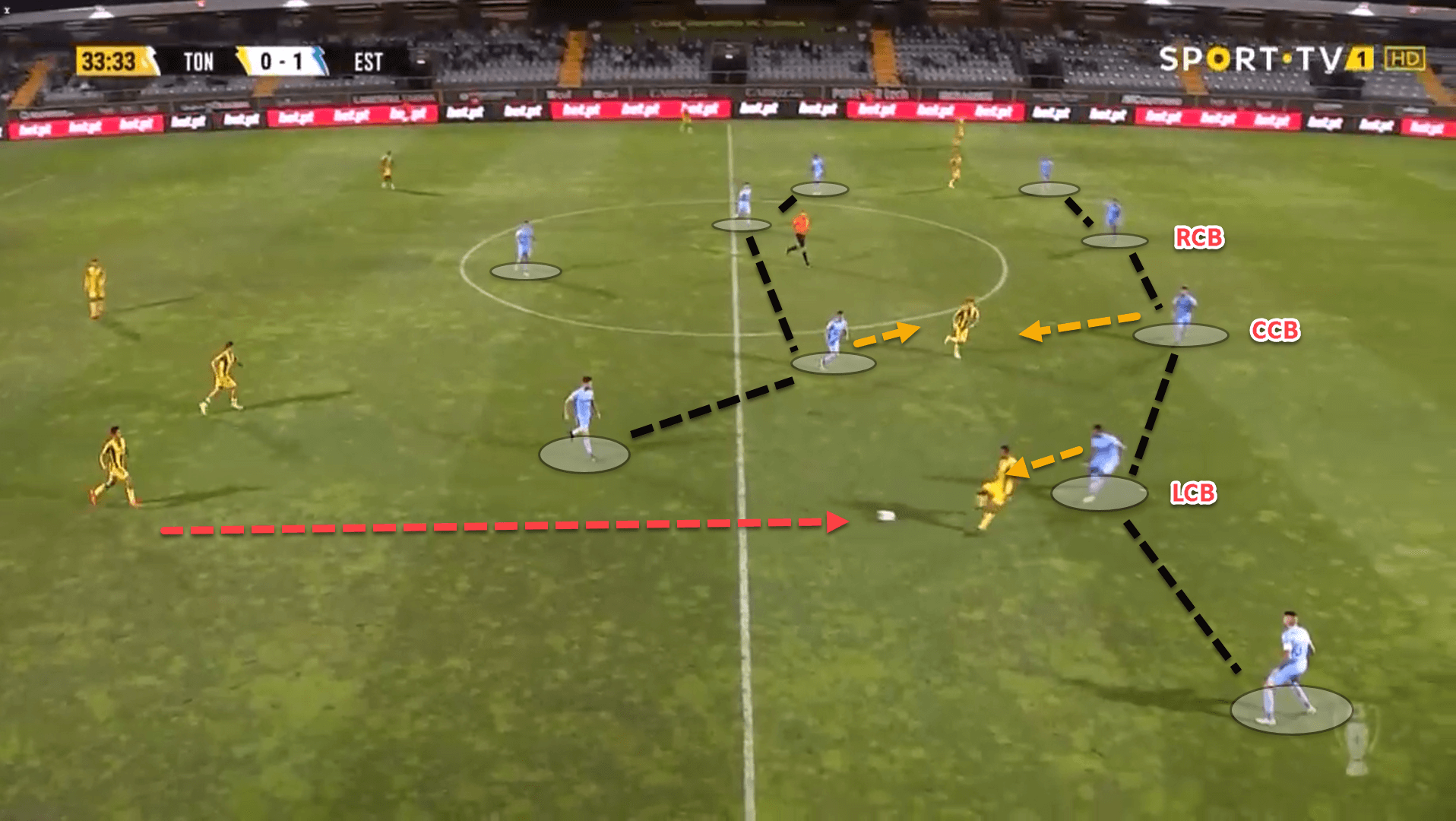
The only issue with switching from a 4-3-3 to a 5-4-1 out of possession is that the double-pivot will almost always be outnumbered in the central corridors and so centre-forward must work hard to force the opposition’s central defenders to play out wide in order to avoid the ball being played through the centre.
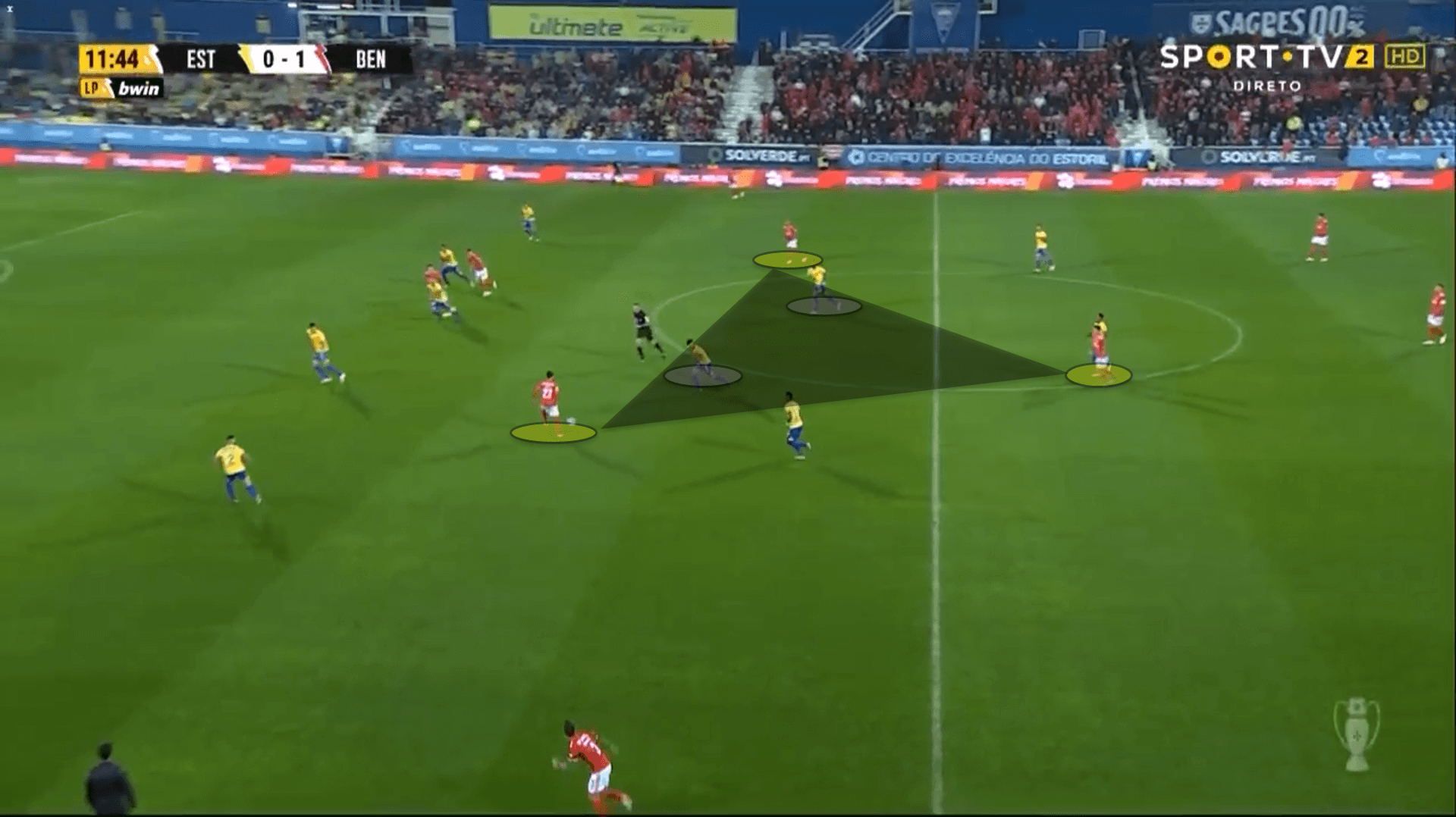
Here, Benfica easily played the ball into the pocket of space between the winger and ball-near central midfielder as the centre-forward failed to stop the pass.
If the nearest centre-back can step out to close down the ball-receiver before he turns on it, then the situation can be avoided, but as seen above this is not always possible and can lead to dangerous attacks.
When the opposition manages to progress the ball into the final third, Estoril’s block retracts to the edge of the penalty area, holding the 5-4-1 shape.
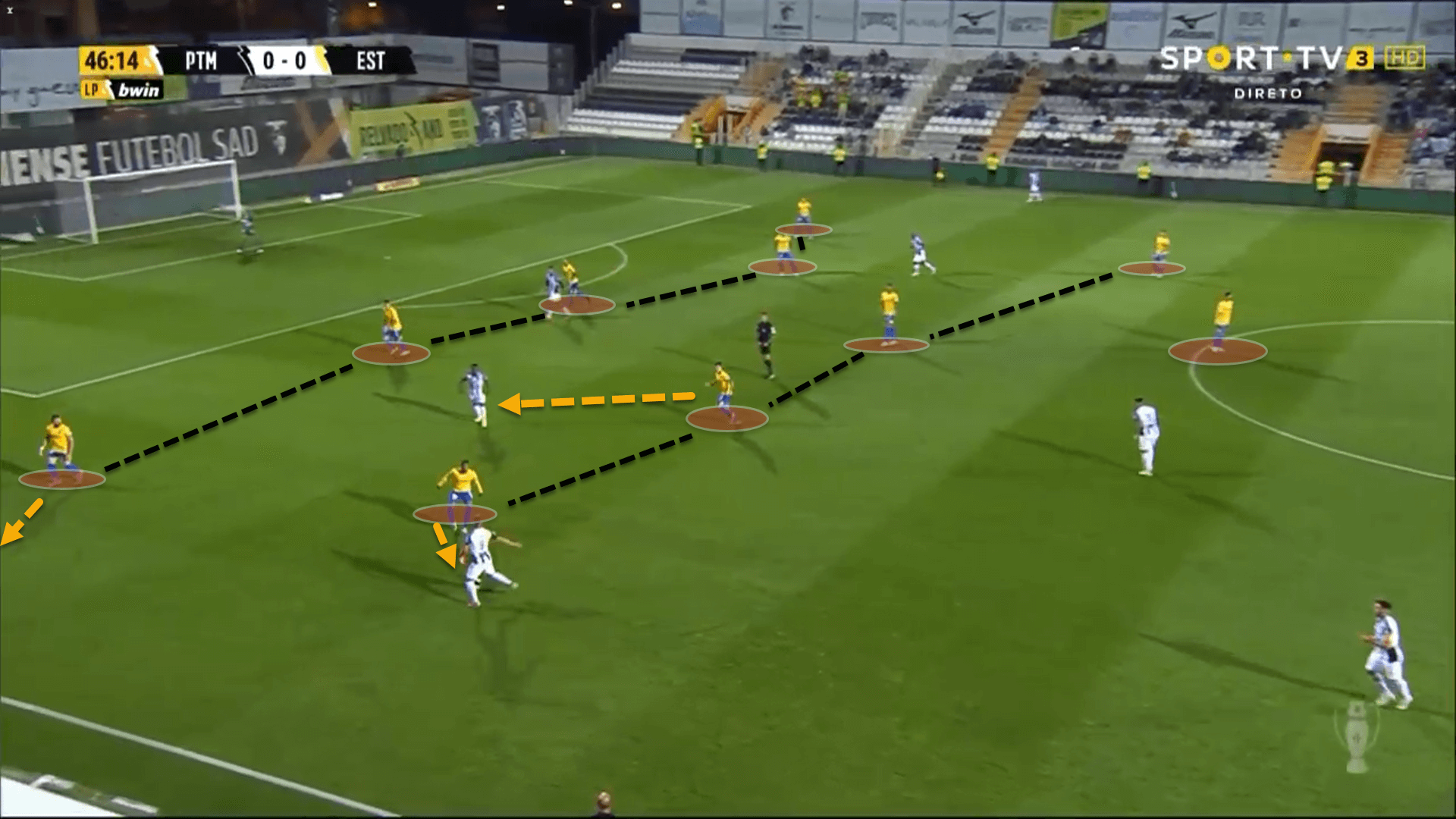
In this phase, as with all the defensive phases, Estoril work extremely hard, cutting off passing lanes, marking players between the lines, and angling their runs while pressuring opponents to force them into predictable areas of the pitch.
Pinheiro’s side have one of the best defensive records in the league so far and have conceded just 9 goals, which is an average of 0.75 goals per 90.
However, their xG against stands at 15.06. This is an overperformance of 6 goals against. Analysing this in further detail suggests that the Canarinhos are conceding 11.97 shots per game which is one of the highest in the league.
While Estoril have defended quite well, forwards are struggling to score against them which has a lot to do with the form of Figueira in goal.
Like any team, Estoril want to force the attacking side down the flanks as crosses have a low conversion rate. When the opposition manages to get to the by-line in advanced positions, the two wingers drops deeper which can create a temporary back seven.
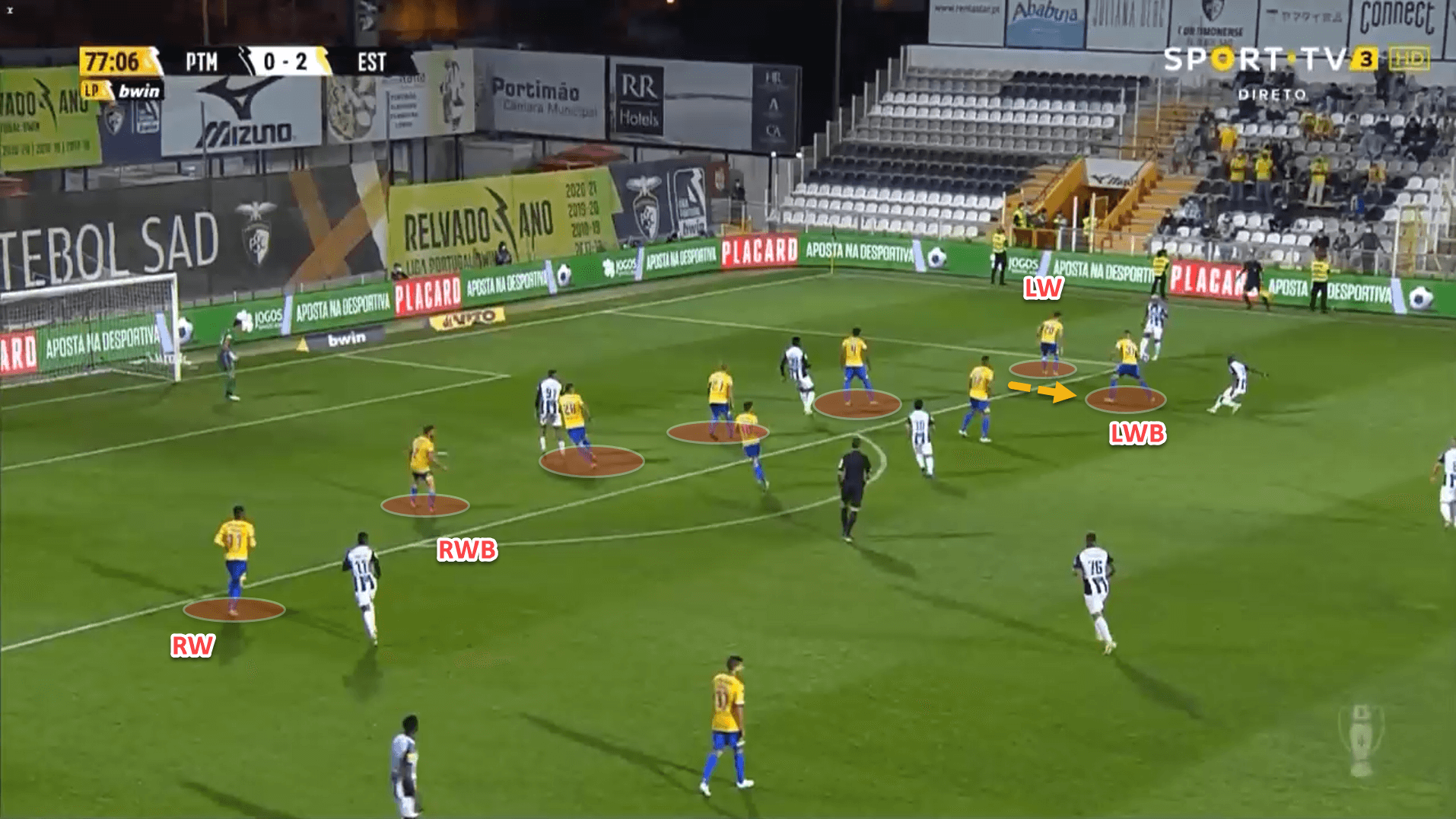
Finally, an important observation to make about a team in the defensive phases is how they react to the ball once it’s cleared out of the box. Do they stay deep and hold their position in front of the goalkeeper or do they push out as quickly as possible to play the offside trap and try and win the second ball.
For Estoril, it’s the latter that the players are instructed do by the Portuguese manager.
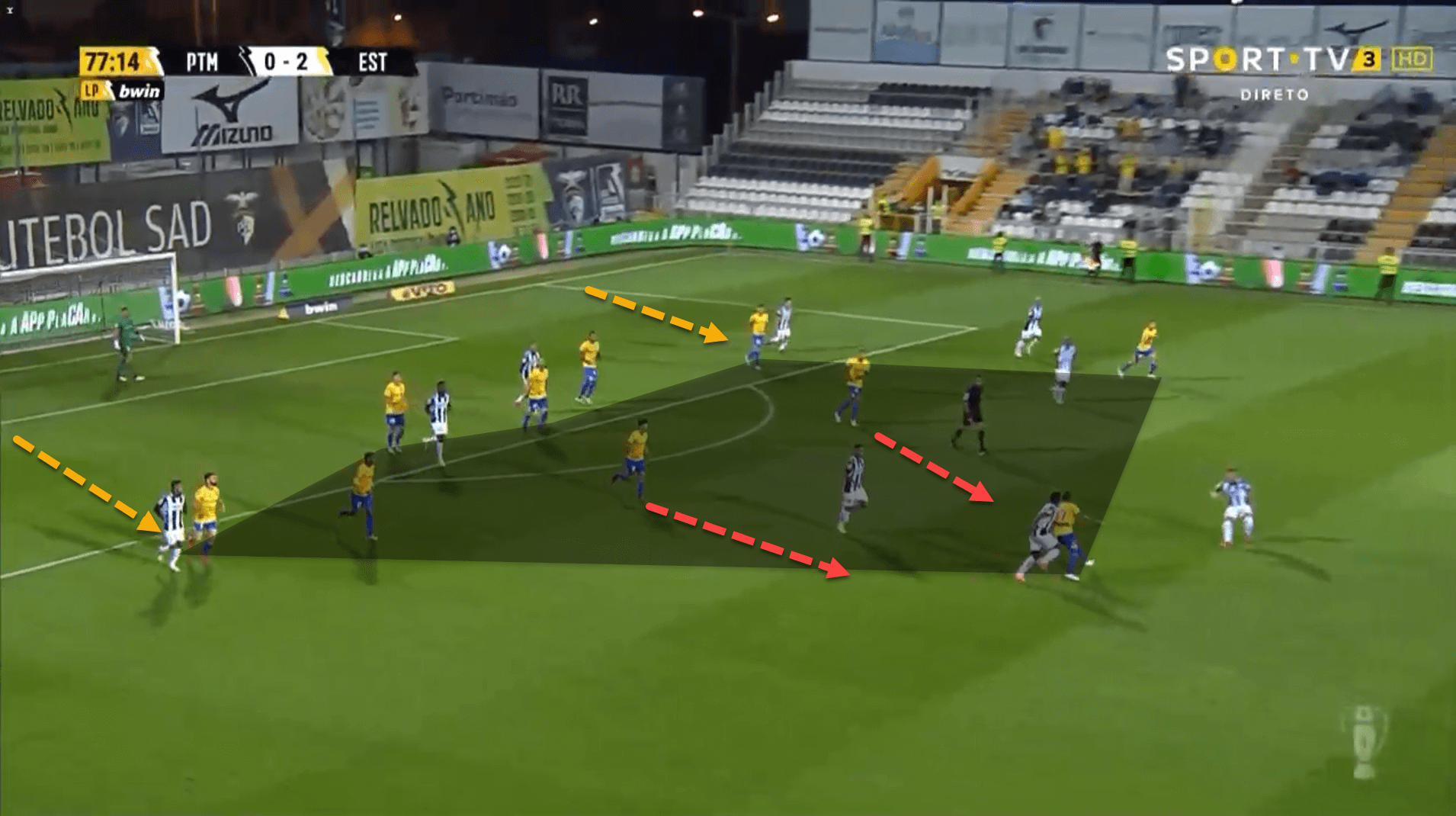
Conclusion
Estoril are a side to keep an eye out for. The Portuguese side are an incredibly well-drilled side which is a huge credit to the work of Bruno Pinheiro, the man in charge.
For a newly-promoted side to be battling for one of the European places is special. While Estoril may not have the squad depth to continue this for the rest of the season, particularly during the home stretch towards the end of the campaign, they have still highly impressed thus far and have been a thorn in the side of the league’s biggest clubs.






Comments